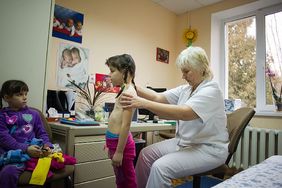This rehabilitation programme is designed for patients with various vertebrogenic diseases, visceropathies, postural disorders, osteochondrosis and scoliosis, etc.
The purpose of the programme is to prevent disability caused by various vertebrogenic diseases, overcome pain and syndromes, correct posture, encourage social and individual adjustment, and improve the quality of life.
The intensive correction phase is conducted in a rehabilitation facility.
It includes:
- A medical examination (assessment of the patient’s vertebrogenic, neurological and somatic condition before and after therapy), analysis of all available medical examinations: X-rays, MRI, discharge from the doctor about the nature of the injury and treatment, etc.
- The main treatment complex using INRS and personally prescribed additional therapeutic procedures.
Each patient is assigned a personal rehabilitation programme that takes into account the type of lesion, type of limb disorder, and somatic and psycho-neurological symptoms.
In addition, the patient is given recommendations on hygiene for static positions, further motor regimen, load volume, and specific tasks and recommendations are drawn up for the period between two rehabilitation courses.
The stabilization and potentiation phase lasting 3 to 6 months is carried out by patients or local medical staff at the patient’s home or place of residence.

